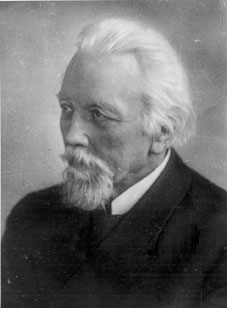 Alexander Petrovich Karpinsky was born on December 26, 1846 (January 7, 1847) in the village of Turyinsky Rudniki, now the town of Krasnoturyinsk, Sverdlovsk Region, died July 15, 1936 in Moscow.
Alexander Petrovich Karpinsky was born on December 26, 1846 (January 7, 1847) in the village of Turyinsky Rudniki, now the town of Krasnoturyinsk, Sverdlovsk Region, died July 15, 1936 in Moscow.
Born in the family of a mining engineer. He graduated from the Mining Institute in St. Petersburg (1866). Adjunct from 1869, Professor in the same place in 1877-96. He actively participated in the organization of the Geological Committee (1882), in which, at first, he worked as a Senior Geologist, in 1885-1903 he was its Director, and in 1903-29, an Honorary Director. Academician A.A. Borisyak wrote that “A.P. Karpinsky was formally the third, but essentially the first Director of the Geological Committee”. Under him and under his direct supervision, geological mapping of the country began, when a small group of outstanding geologists (F.N. Chernyshev, S.N. Nikitin, I.V. Mushketov, etc.) for 10-15 years brought Russia in a row of advanced countries from the geological surveying viewpoint.
In 1886, he was elected Adjunct of the Petersburg Academy of Sciences, in 1889, an Extraordinary and in 1896, an Ordinary Academician. From 1916, he served as Vice President of the Academy of Sciences, and from May 15, 1917, became its first elected President. Under his leadership, work of the Academy of Sciences was reorganized. A.P. Karpinsky played a large role in the study of the country's productive forces. Scientific activity of A.P. Karpinsky was versatile. He compiled integral geological maps of the Urals and the European part of the USSR. The works of A.P. Karpinsky on tectonics, palaeogeography and palaeontology are particularly known. He first revealed the main tectonic structural features of the Russian Platform, indicating (in 1880) the presence of a crystalline folded basement and sedimentary cover, highlighting (in 1883) a strip of displaced sedimentary rocks in the south of Russia. At the 2nd IGC Session (Bologna, 1881) paper “The Experience of the Systematic Unification of Graphic Symbols in Geology” proposed by A.P. Karpinsky, written in connection with the needs of world geological mapping, received the second prize and as a result colouring of the Mesozoic (Triassic – purple, Jurassic – blue, Cretaceous – green) and Cenozoic (yellow tones) was approved by the IGC session on A.P. Karpinsky, and for the Palaeozoic, the colours proposed by the Swiss geologist A. Heim were adopted.
Later on (1887 and 1894), applying the method of tectonic analysis using palaeogeographic constructions developed by him, A.P. Karpinsky showed that the extension of structures created by the oscillatory movements in the earth's crust within the Russian Platform, in the Early Palaeozoic was parallel to the Baltic Shield, and later on, to the system of the Greater Caucasus or the Urals ridges. Only after the work by A.P. Karpinsky, the phenomena of transgressions and regressions received their true scientific explanation in geology. As stated in one of the latest editions of the History of Geology (1973, p. 388): “These generalized studies by A.P. Karpinsky received high praise and international recognition from his contemporaries. In fact, the existence of a new young science, palaeogeography, was confirmed”.
In 1899, A.P. Karpinsky’s monograph “On the Remains of Edestidae and on their New Genus Helicoprion” was published. A.P. Karpinsky considered the most important result of his research to be that in the monograph “the reckoning of Edestidae as elasmobranchs is proved by their histological structure and shagreen scales”. The use of the histological method in the palaeontologist’s research was an innovation. Therefore, Alexander Petrovich himself considered its application to be one of the important achievements of his monograph on Helicoprion. In 1906, his monograph “On Trochilisks” was published. In this comprehensive study, A.P. Karpinsky proved that trochilisks and forms close to them are not animals (foraminifera, or intestinal), as the first researchers of these organisms believed, but calcified sporophydia of higher thalloid plants, charophytes.
One of the first in Russia A.P. Karpinsky used (1869) microscope to study rocks. At the 8th Session of the International Geological Congress in 1900 in Paris, A.P. Karpinsky made a presentation on the principles of classification and nomenclature of rocks, indicating that mineralogical composition and structure should be of primary importance in the classification of igneous rocks.
Geological and petrographic studies of A.P. Karpinsky are closely related to practical geology. General geological work of A.P. Karpinsky, in particular his geological and palaeogeographic maps, served as the basis for broad practical forecasts in mineral exploration.
For a set of works A.P. Karpinsky was awarded the Konstantinovsky Medal by the Russian Geographical Society (1892) and the Cuvier Prize by the French AS (1921). A.P. Karpinsky was a permanent representative of Russian geological science at international geological congresses (starting from the 2nd Session in Bologna in 1881); participated in the compilation of the geological map of Europe and in the unification of graphic images in geology. He was the Chairman of the Organizing Committee and the President of the 7th Session of the International Geological Congress (1897, St. Petersburg). From 1899 to 1936, he was President of the Mineralogical Society. Elected an honorary member of many foreign academies of science.
A.P. Karpinsky worked a lot in various commissions of both scientific and organizational nature. A city in the Sverdlovsk Region, a volcano on the island of Paramushir (Kuril Islands), a mountain in the Northern Urals, a bay near the Taimyr Peninsula, a bay on the Pacific Ocean, a glacier on Novaya Zemlya, and karpinskite mineral, a complex silicate, Museum of the USSR Academy of Sciences and a street in Leningrad, etc. are named after A.P. Karpinsky. Our institute bears the name of A.P. Karpinsky. In 1946, the USSR Academy of Sciences established the A.P. Karpinsky Prize and Gold Medal, awarded for outstanding work in the field of geology.
He was buried in Red Square near the Kremlin wall.